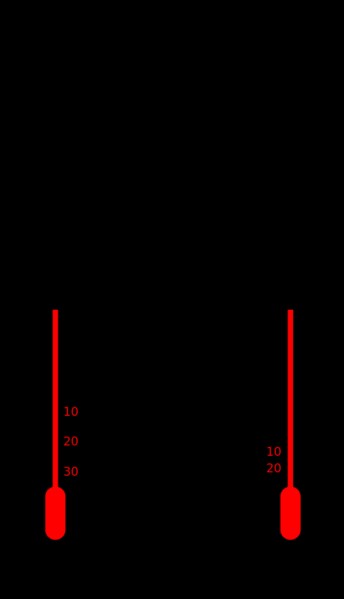When it comes to measuring temperature, two scales dominate global conversation: Celsius and Fahrenheit. Often, confusion arises when switching between these systems, especially for those unfamiliar with both. This article provides a comprehensive comparison of Celsius and Fahrenheit, detailing their origins, usage, and key differences to help you understand and navigate both scales with ease.
Delving into the Celsius Scale
The Celsius scale, originally known as centigrade, is part of the metric system and is used by the vast majority of the world. It’s named after Swedish astronomer Anders Celsius, who introduced a similar scale in 1742. The Celsius scale is defined by two key points related to water:
- Freezing point of water: 0 degrees Celsius (°C)
- Boiling point of water: 100 degrees Celsius (°C)
This straightforward 100-degree interval between freezing and boiling makes Celsius incredibly intuitive for scientific and everyday use. Historically, the Celsius scale was directly tied to the melting and boiling points of water at standard atmospheric pressure. While the modern definition is now anchored to absolute zero and the triple point of water for higher precision in scientific applications, the practical understanding remains centered around water’s freezing and boiling points.
Exploring the Fahrenheit Scale
The Fahrenheit scale, primarily used in the United States, its territories, and a few other countries, is named after German physicist Daniel Gabriel Fahrenheit, who proposed it in 1724. Fahrenheit based his scale on different reference points:
- Freezing point of water: 32 degrees Fahrenheit (°F)
- Boiling point of water: 212 degrees Fahrenheit (°F)
In the Fahrenheit scale, the difference between the freezing and boiling points of water is 180 degrees. Fahrenheit originally defined 0°F as the freezing point of a brine solution and 96°F as the approximate human body temperature (though later adjusted to 98.6°F).
Key Differences: Celsius vs. Fahrenheit
While both scales measure temperature, their fundamental differences lie in their reference points and degree size:
- Reference Points: Celsius is anchored to the freezing and boiling points of water at 0°C and 100°C, respectively. Fahrenheit uses 32°F for freezing and 212°F for boiling water.
- Degree Size: A degree Celsius is larger than a degree Fahrenheit. Specifically, one degree Celsius is equal to 1.8 degrees Fahrenheit. This means temperature changes appear numerically larger in Fahrenheit than in Celsius for the same actual temperature difference.
- Usage: Celsius is the standard for scientific, meteorological, and general-purpose temperature measurements worldwide, except in the United States and a few other regions. Fahrenheit is mainly used for everyday temperature reporting in these regions.
To illustrate these differences, consider the following comparison:
| Feature | Celsius (°C) | Fahrenheit (°F) |
|---|---|---|
| Freezing point of water | 0 | 32 |
| Boiling point of water | 100 | 212 |
| Absolute Zero | -273.15 | -459.67 |
| Average human body temp. | 37 | 98.6 |
| Water freezes at sea level | 0 | 32 |
| Comfortable room temperature | 20-25 | 68-77 |
 Thermometers showing Celsius and Fahrenheit scales side by side, illustrating the different freezing and boiling points of water on each scale.
Thermometers showing Celsius and Fahrenheit scales side by side, illustrating the different freezing and boiling points of water on each scale.
Global Usage: Why Two Scales Persist?
The global adoption of Celsius is almost universal, driven by the metric system’s standardization. Most countries transitioned to Celsius in the latter half of the 20th century as part of metrication efforts.
However, the United States continues to primarily use Fahrenheit for public temperature reporting, weather forecasts, and everyday contexts. This is largely due to historical reasons and the established infrastructure and familiarity with the Fahrenheit scale within the US. While scientific, industrial, and many technical fields in the US also use Celsius, Fahrenheit remains prevalent in general public communication.
Interestingly, even in countries that have officially adopted Celsius, older generations may still refer to Fahrenheit, particularly for air temperatures. In some instances, like weather reports in the UK, Fahrenheit might be occasionally mentioned for the benefit of those born before the widespread adoption of Celsius.
Converting Between Celsius and Fahrenheit
Converting between Celsius and Fahrenheit is straightforward with these formulas:
Celsius to Fahrenheit:
°F = (°C × 9/5) + 32
Fahrenheit to Celsius:
°C = (°F – 32) × 5/9
For example, to convert 25°C to Fahrenheit:
°F = (25 × 9/5) + 32 = 45 + 32 = 77°F
And to convert 77°F back to Celsius:
°C = (77 – 32) × 5/9 = 45 × 5/9 = 25°C
A Brief History: The Evolution of Temperature Scales
Daniel Gabriel Fahrenheit originally developed his scale using brine and human body temperature as reference points. His mercury thermometer offered greater accuracy than previous instruments, contributing to the scale’s initial adoption.
Anders Celsius proposed his scale with 0°C as the boiling point of water and 100°C as the freezing point. This was later inverted to the now-familiar form with 0°C as freezing and 100°C as boiling by Carl Linnaeus and others. The simplicity and decimal nature of the Celsius scale aligned perfectly with the burgeoning metric system, leading to its widespread international acceptance.
While Fahrenheit may have been favored in some English-speaking countries historically due to arguments about smaller degree increments allowing for more precise communication in everyday contexts, the global trend towards standardization and the ease of use of the Celsius scale have made it the dominant temperature scale worldwide.
Conclusion
Understanding the difference between Celsius and Fahrenheit is essential in a globalized world. While Celsius provides a simple, metric-friendly system used across most of the globe, Fahrenheit remains relevant, particularly in the United States. Knowing their origins, differences, and how to convert between them ensures clear communication and comprehension when dealing with temperature measurements in any context.
